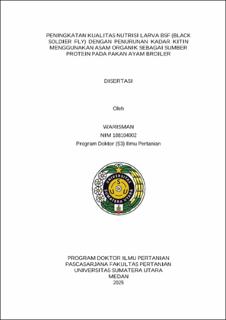| dc.description.abstract | Quality animal feed is one of the determining factors for the success of the
livestock industry and is the largest component in these business activities, which
is 50-70% and the protein component has an important role in an animal feed
formula because it is involved in the formation of body tissues and is actively
involved in vital metabolism such as enzymes, hormones, antibodies and so on.
Protein is the most expensive component of feed compared to others. As a result,
the economic fulfilment of protein sources is quite burdensome for production
costs, therefore the current feed studies are aimed at finding alternative protein
sources by utilising insects. Another favourable factor is that insect-based protein
sources do not compete with humans, making them suitable for use as feed
ingredients for livestock including poultry and fish.
This research was designed with 3 stages of research, namely: Phase I
(characterisation of nutrient content analysis of BSF larvae at 14 days, 16 days, 18
days and 20 days) to see the optimisation of chitin and nutrient content of BSF
larvae descriptively by summarising the data on a curve that connects the
intersection of chitin and nutrient content observed; Phase II (chemical and
biological tests of BSF larvae nutrition after processing using organic acid with
steaming and without steaming process) to see the best processing to reduce chitin
content and chemical and biological nutritional quality in broiler digestibility
using a complete Randomised Block Design Factorial (RALF) 3 factors and 3
replicates, namely the first factor of physical treatment (BSF without steaming
and steamed BSF), The second factor is the dose of organic acid (2%, 4% and
6%), the third factor is the type of organic acid (acetic, propionate and citric) if
there is a significant difference, followed by the Duncan test;Phase III (test of the
best post-processing BSF larvae as an alternative substitute for fishmeal in feed
formulations in vivo on performance, cholesterol content, protein efficiency ratio
(REP) and income over feed cost (IOFC) in broilers to see the best response of
chickens to BSF larvae substitution using a completely randomised design (CRD)
5 treatments 4 replicates, namely P0 (100% fishmeal); P1 (fishmeal 75% BSF
larvae 25%); P2 (fishmeal 50% BSF larvae 50%); P3 (fishmeal 25% BSF larvae
75%); P4 (BSF larvae 100), if there is a significant difference followed by Duncan
test. Preparation of materials and treatments were carried out in the Basic Sciences
Laboratory (IID) Universitas Pembangunan Panca Budi, Medan. Analysis The
research was conducted from June 2022 to May 2023. The results of the research
in Phase I that the optimum age of BSF larvae to be used as feed ingredients is 18
days of rearing (market and restaurant waste media), because there is an
intersection of the percentage curve of each nutrient at that age of rearing.The
results of Phase II research that the best treatment of the results of Chemical and
Biological tests of BSF larvae after processing with organic acids is treatment
T02%A (BSF larvae without steaming, dose of 2% acetic acid) because the chitin
content is significantly different from the lowest compared to other treatments,
namely 4.15 percent, the highest PK content of 44.17 percent, containing fat
iii
which is not significantly different from other treatments, namely 38.12 percent,
the GE content is quite optimal at 4. 303 cal, has a fairly high BO content of 86.43
per cent, produces protein digestibility which differs significantly from the highest
at 71.96 per cent, energy digestibility of 63.31 per cent is not significantly
different from other treatments, and produces the highest BO digestibility of 66.97
per cent.The results of Phase III research that post-processing BSF larvae can be
used in substituting fish meal in broiler feed up to 75 per cent (P3), because it
produces feed consumption of 2,501.5 g/head which is not significantly different
from the control 2,472.5 g/head (P0), body weight gain of 1,392.5 g/head which is
not significantly different from the control 1. 414 g/head, feed conversion 1.80
which was not significantly different from control 1.75, protein efficiency ratio
2.86 which was not significantly different from control 2.99, meat cholesterol
content 74.3 mg/100 g which was not significantly different from control 76.3
mg/100g, and IOFC value Rp 12,778 which was better than control Rp 12,510
although not statistically significantly different. | en_US |


